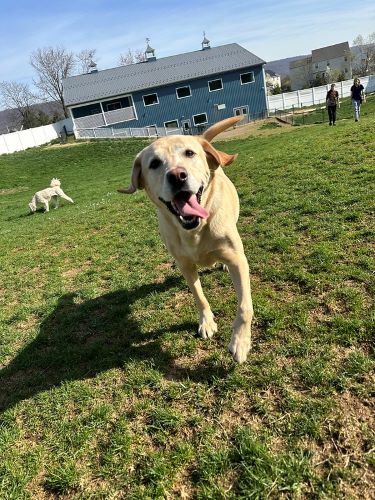Breed Spotlight: Understanding and Caring For Labs

It’s true that, in many respects, every dog breed is a little bit different. They may have personality traits, diet preferences, and activity levels, all of which can be impacted by their breed lineage as well as their immediate family’s genealogy. Learning these unique traits about your dog can help you connect with them better and develop a deeper understanding of how to give them a good quality of life.
With this in mind, our breed spotlight series aims to describe some of the most important facts about each of the more popular breeds. We certainly understand that every dog is different here at Greenlin Pet Resorts, which is why we tailor our dog training courses and dog daycare routines to fit each dog’s preferences. At the same time, breed traits — both physical and behavioral — can have a large impact on a dog’s disposition, needs, and how they like to have fun.
Our first spotlight is on one of America’s most popular dogs of all time: the labrador retriever. This is a loyal, loving, and active breed that is popular among families thanks to their typically tame and even-tempered dispositions. This breed also makes great working dogs in fields like medical service, search and rescue, and therapy. They are intelligent and adorable dogs, making them one of the well-loved and a common sight in families all across the country!
Read on to learn from our labrador care guide.
Labrador Retriever: Breed Information, Background, and History
The Labrador retriever, otherwise referred to as the ‘lab’ for short, developed as a working dog in the breed’s early days. Labs were once a type of British retriever gun dog whose job was to retrieve hunted waterfowl for their owner. This subsect of hunting dogs is specifically trained to be accustomed to the loud noises of a gun so they can concentrate and work around the noise. A British retriever gundog was tasked with identifying their hunter’s prey and marking where it was downed to retrieve later.
The earliest origins of the labrador retriever are actually not in England but in Newfoundland, Canada when Spanish, Portuguese, French, and English fishermen migrated to the area. As these settlers brought their various breeds of dogs to the island, the pups evolved into the now-dormant breed the St. John’s Dog. These dogs were described to have a water-resistant coat, webbed feet, and a strong tail. Today’s labrador retriever is described as the smaller version of the St. John.
After seeing how resilient and efficient the St. John water-loving dog was in their work tasks, the British began importing these dogs overseas for their own fishermen — and eventually other hunters, too. They began to cross St. John with other dog breeds to optimize personality traits, and not soon after this practice began, a purebred St. John became a rarity. Eventually, the importation of these dogs became prohibited in England due to the heightening concern for rabies and the fact that the St. John dog was depleted in numbers. From there, the labrador retriever evolved from closed-off lines that were refined and bred to become the loveable household companion we know them as today.
Common Traits in Modern Day Labs
Every dog will have their own unique personality, but some of the most consistently reported traits within labrador retrievers include:
- Friendly and sociable with humans and other pets: The labrador retriever is known for its friendly manner. Labs are oftentimes nice to strangers, which means they likely won’t make the most protective guard dog. However, they’re snuggly and generally good with kids or other pets! If your household already contains a pet, bringing a lab home may be a safe option for adding to the family without creating a power struggle between the new and original pet.
- Fast learners and efficient workers: This breed is naturally intelligent, so they are quick learners when they need to be taught a command or a task. Labradors are working dogs and enjoy staying mentally stimulated. If your labrador retriever has no challenge or task to stay busy, they may get bored fast.
- High energy levels: As a breed, labs are known for their excited, high-energy behavior. Labrador retrievers have amazing stamina and can run around playing for hours. An under-stimulated labrador may develop unwanted behaviors like chewing or tearing personal belongings to blow off some steam. Random spurts of energy in a lab are actually a sign of good health, too.
- Heavy appetites: Labrador retrievers have big appetites to fuel their high-energy levels and excited personalities. Because these dogs are food-driven, they may be prone to begging and even stealing from your plate! A recent study also confirms that the labrador’s food-motivated behavior is actually prompted by genetics — a gene alteration.
- Loyal: One of the traits that makes the labrador retriever one of the most popular breeds is their loyalty to their owners. They love and care for their families, making great task runners for the adults and can even be babysitters for little ones. You may see your labrador corralling young toddlers as they play to ensure their safety or picking up stray objects that scatter around the floor. These are just small ways that your lab tells you they love you.
- Loves water: These dogs are notorious for their love of water. Stemming from the evolution of the breed, labrador retrievers are built for these conditions with their boxy build, short-haired coat, and powerful tails. Whenever possible, entertain your lab with fun water activities like the sprinkler, hose, or kiddie pool.
Genetic Predispositions For Labrador Retrievers
Caring for labs starts with understanding their background. Every pet owner worries about the health of their furry friend, and understanding what conditions and genetic diseases your dog is predisposed to can help you build a diet and activity plan that maximizes their quality of life.
Some of the most common health issues for labrador retrievers include:
- Allergies: The labrador’s immune system produces more of an allergic antibody called immunoglobulin E, or IgE, making them prone to all kinds of allergies, including environmental, seasonal, and food-based.
- Obesity: A team of researchers led by The Institute of Metabolic Science at Cambridge University found a specific variant of a gene known as POMC to be strongly associated with weight, appetite, and obesity. 1 in 4 labradors has this gene, making it difficult for them to control their food intake without support from their owner.
- Ear infections: Labs have floppy ears, which makes them mildly prone to ear infections because of the low air circulation in the ear canal. During your pup’s annual vet visit, their doctor should check and clean their ears.
- Hip dysplasia: This developmental disorder is characterized by osteoarthritis (OA) and joint laxity. It is an inherited condition that labradors are predisposed to endure. Signs of hip dysplasia include limping, bunny hopping, stiffness, and muscle loss.
- Centronuclear myopathy: This inherited condition is also known as Hereditary Myopathy of the Labrador Retriever (HMLR) because it primarily affects this breed. The condition is characterized by excessive internalized nuclei, which results in muscle weakness and poor muscle tone. This condition can lead to physical disabilities in a dog
- Hereditary Nasal Parakeratosis (HNPK): This is a genetic disorder specific to labrador retrievers that results in a dry, crusty nose. It can be irritating and uncomfortable for your pup but may look like a simple case of nasal dryness to you as their owner.
Ensure a Well-Rounded Diet for Your Labrador Retriever
All dogs will have their own preferences for texture, flavor, and even brands of food.
As the dog owner, it is your job to ensure that the food fits their breed’s specific nutritional needs. For example, in their senior years, a labrador owner may consider feeding their pup a specialized food for joints. Alternatively, in the spring months, a lab owner may consider adding a supplement for environmental allergens like pollen.
A well-rounded diet for a lab generally includes:
- High protein
- High fat
- Low carbohydrates
- Vitamins and minerals
- Water
Labs Love Training and Can Benefit Greatly From It
With their high energy levels and tendencies to want to be involved in whatever their household members are doing, labs — just like any other breed — can be sometimes prone to undesirable behaviors if they are not properly trained and integrated into the household.
Behaviors linked to boredom or excess energy can include excessive barking, hyper-fixation on objects or things like wildlife outside, chewing, or a drive to get into food, trash, or other off-limits items.
Labs also tend to want to be near whatever is going on, especially if food is involved! Accordingly, they may beg, pester, knock over young children, or want to jump on furniture even when they are not allowed.
The good news is that labs are both intelligent and highly praise-motivated. Both can work in tandem under a certified dog trainer at Greenlin so that your furry family friend understands boundaries and is primed to satisfy their motivators in positive ways. Best of all, training programs can include guidance for owners and every member of the household to reinforce desired behaviors and reward your lab for wanting to be involved in the family dynamic.
Your Labrador Will Love the Greenlin Life
Pups that come to Greenlin are treated like A-list celebrities, enjoying personal attention from loving pet care specialists, luxury amenities, and all the space they could possibly need to play.
The dog trainers and other professionals tasked with caring for your lab while they’re here understand the uniqueness of the breed and will optimize their day to stimulate their high-energy, sociable behavior. We can provide them with dog daycare to help them burn off energy and make new friends, and we also have award-winning dog boarding facilities available to ensure they get all the supervision and attention they demand while you aren’t able to be with them.
Greenlin Pet Resorts is a top-rated pet care facility, so reach out to one of our six locations in the Harrisburg area to learn more about our services and how we can help your lab live the best life it can. or book your pet’s stay online!
Click on the location nearest you to book online!
